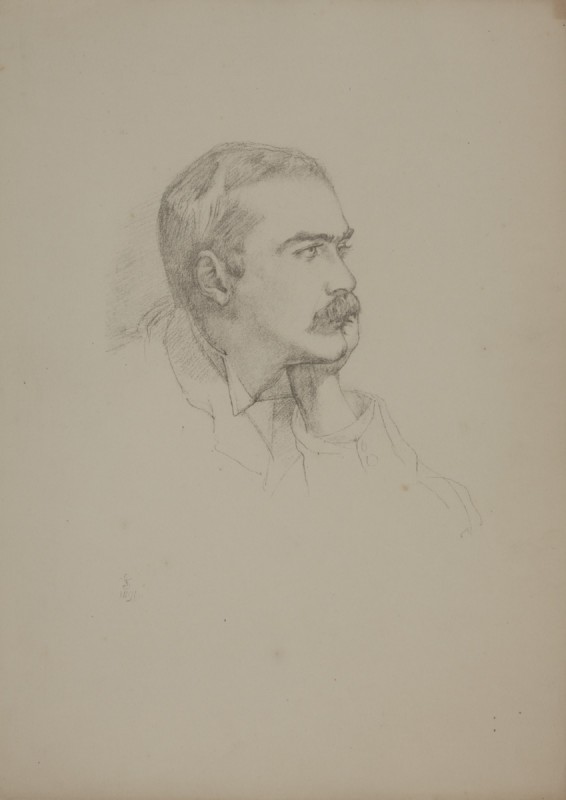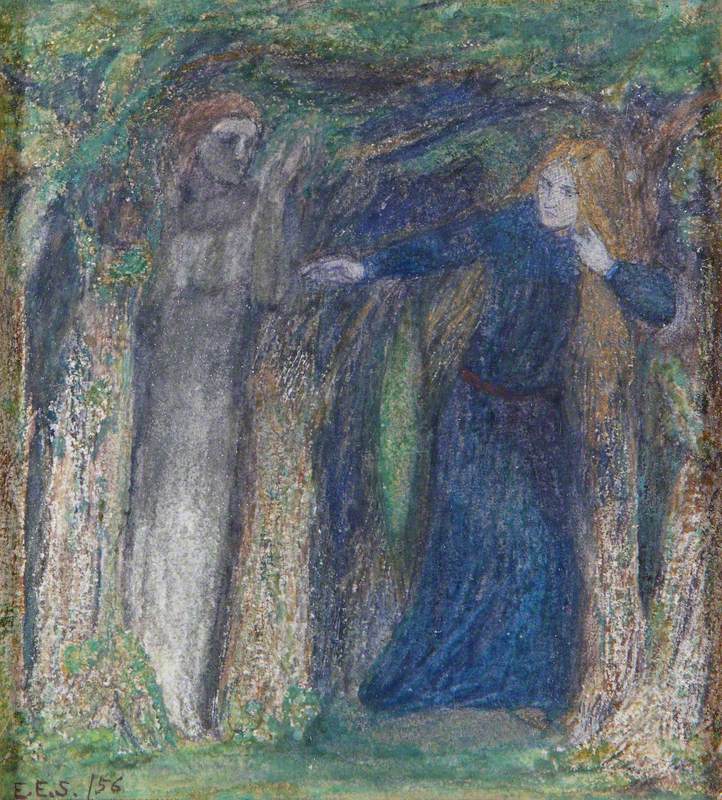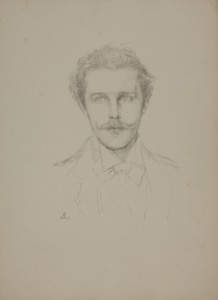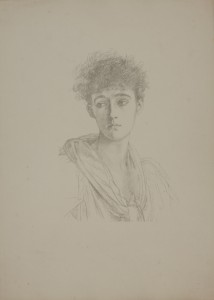When Colonel Charles Lindsay noticed what a talented artist his five-year-old daughter was, he asked the Pre-Raphaelite Edward Burne-Jones to teach the little girl art. Burne-Jones replied ‘Do not give her lessons. Let her make studies of herself before a looking glass. She will never find a more sedate model to sit for her.’ It was on this advice that Marion Margaret Violet Lindsay, later Violet Manners (1856–1937), Marchioness of Granby and Duchess of Rutland, began her artistic career.
Violet Manners, Marchioness of Granby and Duchess of Rutland
Violet was considered the ‘queen’ of ‘The Souls’, a fashionable aristocratic social circle that favoured intellectual pursuits and avant-garde artistic tastes. Drawn together by the death of Right Honourable Laura Lyttelton, Violet and her friends, Lady Brownlow, Lady Elcho and Margot Tennant formed a close group that shared interest in art, literature and all things cultural. They gathered like-minded people to them and were known for a while as ‘The Select’ and ‘The Gang’, until Lord Beresford called them ‘The Souls’ after observing that they sat around talking about each other’s souls.
Her cousin was Coutts Lindsay, who owned the Grosvenor Gallery where she held exhibitions of her work, but she also exhibited at the Royal Academy as well as in America and France. She held an exhibition of her works at the Russell-Cotes Art Gallery & Museum in 1933. One of her portraits, of Megan Lloyd George (1902–1966), MP, was purchased by the museum. A further 39 silver-point drawings were donated to the museum in 1974 by Miss Kathleen Burtchaell, who had retired to Bournemouth. Below are some of the vivid portraits of her social circle, a few of which appear in the exhibition ‘At the Heart of ‘The Souls’: The Drawings of Violet Manners, Duchess of Rutland’ (1st November 2016 to 24th April 2017).
'Mouche', Lady Ulrica Duncombe
Lady Ulrica Duncombe, afterwards Baring (1875–1935)
1896
Violet Manners (1856–1937) 
Lady Ulrica Duncombe (1875–1935), also known as ‘Mouche’, and her three sisters were renowned beauties. According to newspaper reports, the four sisters had their food selected for them, were regularly weighed and measured ‘in order to promote perfection of form and colour’. They were made to wear gauze veils to avoid freckles and they washed their faces every morning in freshly gathered dew.
Her engagement to Arthur Winnington-Ingram, Bishop of Stepney was announced in April 1899 and seen as a mark of her intellect and moral sense. She returned to her family home in Yorkshire after she decided that she ‘admired him rather than loved him’ and the engagement was dissolved. She married decorated soldier General Everard Baring in 1904.
Mrs Beerbohm Tree
Former Queen’s College, London, classics scholar Helen Maud Holt (1863–1937) took to the stage in a student production of a Greek drama. She moved onto the professional stage in 1883, marrying fellow actor Herbert Beerbohm Tree the same year. The husband and wife partnership resulted in many performances of Shakespeare, W. S. Gilbert, and Oscar Wilde. She had three daughters who followed her onto the stage, but her husband had many affairs, including one with actress May Pinney Reed, whose grandson was the actor Oliver Reed.
According to The Manchester Guardian in her obituary of 1937, Mrs Beerbohm Tree was ‘a witty woman, and by no means an unimportant actress’. Her husband died in 1917, but Helen survived him by 20 years. Her films included Little Dorrit (1920) and The Private Life of Henry VIII (1933) with Charles Laughton.
Mr Henry Cust
Famous for his love life rather than his professional life, Henry John ‘Harry’ Cockayne Cust (1861–1917), MP, JP, was an author, poet and editor of the Pall Mall Gazette. He was romantically attached to a vast swathe of late Victorian high society, including Pamela Wyndham and Violet Manners, but eventually married Nina Welby-Gregory after she claimed he had made her pregnant, although the couple remained childless. Harry Cust is the basis of many of humorous and salacious stories connected with the otherwise intellectual Souls, including a naked tennis match with George Curzon, governor of India. As a result of his many affairs, it is rumoured that Cust fathered many illegitimate children including Lady Diana Cooper, née Manners, and (less plausibly) Margaret Thatcher’s grandmother.
Cust was a member of ‘The Souls’, with Pamela Wyndham, Margot Asquith, Arthur Balfour and many others pictured here. He died suddenly of a heart attack at his home in 1917, and his wife Nina immortalised him in marble in a stunning tomb at the family home, Belton Hall in Lincolnshire.
'Nina', Mrs Henry Cust
Emmeline Mary Elizabeth ‘Nina’ Welby-Gregory (1867–1955) was the daughter of Queen Victoria’s maid of honour. She married Harry Cust, the golden boy of ‘The Souls’, in 1893 as the result of a purported pregnancy and as a result was not close to the female members of the group, due to claiming their favourite bachelor.
As a talented artist, she exhibited twice at the Royal Academy with her sculpture and her drawings. She also published an account of the travels of her grandmother and mother, who travelled widely during the Victorian period to America, Spain, Greece and the Middle East.
Princess Beatrice
HRH Princess Henry of Battenberg (Princess Beatrice) (1857–1944)
1891
Violet Manners (1856–1937) 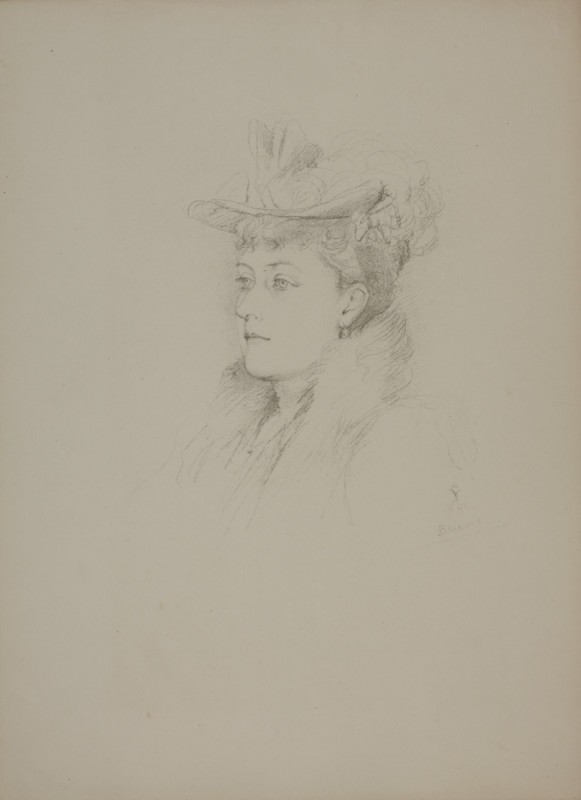
Always known as ‘Baby’, Princess Beatrice Mary Victoria Feodore (1857–1944) was the youngest child of Queen Victoria and Prince Albert. When her father died when she was four years old, Princess Beatrice became the constant companion to her mother throughout her many years of mourning. Beatrice sorted the Queen's correspondence from cabinet ministers each morning, and deputised for her at less formal occasions like tree plantings.
When Beatrice informed her mother she intended to marry Prince Henry of Battenberg, the Queen refused to speak to her for seven months. However, after the marriage, the Queen made Prince Henry Governor of the Isle of Wight and the family lived together at Osborne House. The Queen also had a darkroom installed at Osborne, as photography was a hobby of Beatrice’s. On her mother’s death, Beatrice was entrusted with editing Queen Victoria’s journals for publication. She destroyed two-thirds of the material that related to personal matters or to people who were still alive, as instructed by her mother.
Pamela, Mrs E. Tennant (afterwards Lady Glenconner)
Mrs E. Tennant, afterwards Lady Glenconner (1859–1920)
1895
Violet Manners (1856–1937) 
Pamela Adelaide Genevieve Wyndham (1871–1928) was the daughter of Hon. Percy Scawen Wyndham. She and her two sisters, Mary and Madeline, were the subject of a famous society portrait by John Singer Sargent. Her parents were members of ‘The Souls’, as were Pamela and her siblings.
She married Edward Priaulx Tennant, 1st Baron Glenconner, in 1895 at the most fashionable wedding of the season. Like many of her social circle, the couple lost a son in the First World War, whilst another son, Stephen Tennant, was a notorious ‘Bright Young Thing’ in the 1920s and ‘30s.
Mr Rudyard Kipling
Joseph Rudyard Kipling (1865–1936), was an author, poet, natural scientist and journalist.
His reputation was somewhat tarnished over the course of the twentieth century due to the strongly patriotic, jingoistic and idealistic nature of his work. Author of The Jungle Book, he was born in India and wrote extensively on life in the colonies during the Victorian era. He also wholeheartedly wrote in support of the First World War, but lost his son John in fighting in 1916. Unlike others of his generation he acknowledged a change in his opinion of the conflict, reflected in the lines: ‘If any question why we died / Tell them, because our fathers lied.’
'Layde', Mrs George Batten
Mabel Veronica Hatch (1857–1916) (Mrs George Batten, also known as ‘Ladye’) was an accomplished singer, pianist and guitar player as well as composer.
A sparkling presence in London society, her lovers included the Prince of Wales, Wilfred Scawen Blunt and the female novelist Radclyffe Hall, who owned a sensual portrait of Mabel by John Singer Sargent. She died after a stroke in 1916 after quarrelling with Hall, who was attracted to a mutual friend, but the couple are buried together in Highgate Cemetery.
The Hon. Neil Primrose
The Hon. Neil Primrose (1882–1917)
1890
Violet Manners (1856–1937) 
Like many of the children of ‘The Souls’, Neil James Archibald Primrose (1882–1917), fought in the First World War, gaining the rank of Captain in the Royal Bucks Hussars. He died from wounds received in action in Palestine in 1917. He was one of 19 MPs who died during the conflict and they are commemorated by heraldic shields in the Commons Chamber. He also has a memorial in St Giles’ Cathedral, Edinburgh.
Princess Troubetzkoy
Princess Troubetzkoy (Amelie Rives) (1863–1945)
1894
Violet Manners (1856–1937) 
Amélie Louise Rives (1863–1945) novelist, poet, painter and playwright was born in Virginia, USA. Her troubled and scandalous first marriage to a descendent of the Astor family took her to Europe where she met such literary luminaries as Oscar Wilde and Henry James. Her most famous novel was The Quick or the Dead, but many of her works were officially banned.
Rumours of drug use, insanity and infidelity followed the couple wherever they travelled and the marriage was not a happy one. It is probably through her affair with British politician and ‘Souls’ member George Curzon that Amélie met Violet Manners.
Four months after her divorce in 1896, Amélie remarried the Russian Prince Pierre Troubetzkoy, an artist and an aristocrat, after Oscar Wilde introduced them in London.
Lady Ribblesdale
Lady Ribblesdale, née Tennant (1858–1911)
Violet Manners (1856–1937) 
Ava Lowle Willing (1868–1958) was a twice-married socialite who became Lady Ribblesdale. She was not only rich but also a famous beauty with hair ‘as white as the snow at St Moritz’. Her first marriage was to Colonel Jack Astor, whom she divorced in 1909 for a $10 million settlement. Astor drowned during his second honeymoon when the RMS Titanic sank.
In 1911 Ava moved to England with her daughter and in 1919, married Thomas Lister, 4th Baron Ribblesdale, who had previously been married to Charlotte Tennant, one of ‘The Souls’.
After Ribblesdale’s death in 1925, Ava moved back to America, and gave up her British citizenship in 1940, leaving her London home to be a shelter for children left homeless by the Blitz.
The Earl of Oxford and Asquith
The Earl of Oxford and Asquith, Husband of 'Margot' (1852–1928)
1892
Violet Manners (1856–1937) 
Herbert, 1st Earl of Oxford and Asquith (1852–1928) served as Liberal Prime Minister in Britain from 1908 to 1916. Unlike many of his social circle, Asquith came from a middle-class family, and his father built up a wool business in order to pay for his son’s education.
Despite being hard-working and austere, stories are rife about his louche behaviour in later life. His nickname among opposition politicians was ‘Squiffy’ because of his fondness for drink and he was well known for his unsubtle flirtation techniques.
During his time as Prime Minister, Asquith oversaw many contentious issues, including Home Rule for Ireland and Votes for Women. Despite never supporting female suffrage as an MP, his reforms to the House of Lords made it easier to pass later on.
Like many of his contemporaries, he lost his son, Raymond, in the First World War. Lieutenant Asquith was a member of ‘The Coterie’, a social group formed mainly by the children of ‘The Souls’, including Diana Cooper, daughter of Violet Manners.
Kirsty Stonell Walker, guest curator of ‘At the Heart of ‘The Souls’: The Drawings of Violet Manners, Duchess of Rutland’ (1st November 2016–24th April 2017) at Russell-Cotes Art Gallery & Museum




